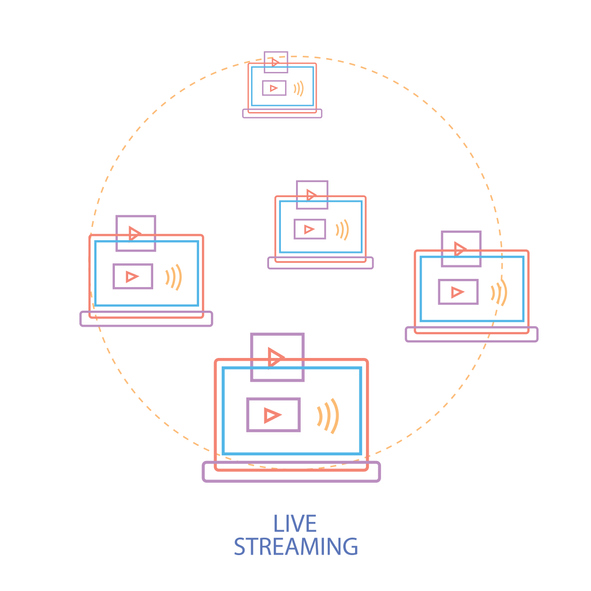Boost Employee Engagement with Live Streaming Corporate Communications
Companies of all sizes often struggle with employee engagement. In fact, Gallup polls estimate that disengaged employees are responsible for $450 to $550 billion in lost U.S. productivity per year. To rectify this disparity, some companies have started to stream live video to better engage their employees. In particular, live streaming corporate communications offer numerous applications for employee engagement.
In this article, we’ll explore some of these options, beginning with a review of live streaming basics. Next, we’ll introduce live streaming corporate communications for education and training purposes. Later, we’ll review 10 examples of successful live streaming corporation communications for companies. These 10 applications for live corporate broadcasts include:
- staff/leadership interactivity
- announcements & meetings
- global connectivity
- workplace culture
- product/service demos
- team integration
- content archiving
- cost-effective scalability
- employee engagement analytics
- internal communications
Additionally, we’ll introduce Dacast’s streaming solutions for live streaming corporate communications. Lastly, we’ll conclude with a review of the future of video for businesses and the workplace in general.
Now, let’s turn to our live streaming introduction, before discussing specific applications for live streaming corporate communications.
Live Streaming: The Basics
For those new to the topic, it’s important to understand how live streaming works in general. Not to worry! We’re here to break it down for live broadcasting newbies. Simply put, live streaming refers to broadcasting video (and audio) content in real-time over the Internet. In other words, broadcaster records and transmits live video (or audio) to viewers around the world. In turn, these viewers can watch or listen to the live broadcast just like a normal, live TV broadcast (e.g., live TV news).


Streaming live video online requires minimal setup–especially when compared to the early days of this technology. So what are the basic components and required live streaming equipment? The essential elements for high-quality broadcasts include:
- a camera
- a microphone
- a fast and reliable Internet connection, and
- a computer or dedicated encoder, to upload your stream to the Internet.
Finally, you’ll also need a live streaming video host like Dacast to deliver your video to viewers. (For a recent review of 10 streaming platform options, you can review this article. You can also peruse our large collection of related articles on the Dacast blog, here.)
Live Streaming Corporate Communications for Education & Training
For businesses, there are many situations in which live streaming is useful. One of the most obvious and widespread examples includes using live streaming corporate communications for education and training.
There’s a great deal of evidence behind video Learning and Development (L&D) as an effective way to train employees. Companies such as IBM and Microsoft have invested heavily in video training for employees. Microsoft estimates that it has avoided annual costs of $13.9 million by investing in a video training platform. Do the math! That’s a ROI of 569% on their initial investment in live streaming corporate communications technology.
There are thousands of other companies using live streaming corporate communications internally. Not surprisingly, many of these have witnessed cost reductions on a similar scale.
Industry Standards Today


Rather than writing a new training guide or conduct a series of meetings, live streaming corporate communications can train employees on basic procedures quickly and easily. Tasks like scheduling meetings, inputting data, setting up conference calls, fulfilling orders, and doing customer service all become simpler and more streamlined when a company trains all staff to the same standard.
In short, live video makes company training simpler and more instantaneous.
Live Streaming Corporate Communications: Applications & Impact
1. Employee Interactivity
A key element of live video is that it encourages two-way interaction. Live-streamed training and meetings allow employees to ask questions and share ideas and concerns. Additionally, live streaming corporate communications facilitate creative collaboration–without a time-delay or the impersonal nature of email communication.
2. Announcements and Meetings
Another impactful use case for live video is the dissemination of important information. This internal communication might include announcements sent to all employees, such as company updates and news about the company’s future. Live video facilitates easy, personal communication whether employees are at company headquarters, off-site locations, or even traveling.


Live streaming corporate communications are useful for annual shareholder meetings, regular staff meetings, and ongoing employee training. For example, Zuora, a SaaS subscription company, uses live streaming to broadcast weekly meetings to employees located in nine different time zones.
3. Global Connectivity
As a company ourselves, we know that training new team members can pose a lot of challenges. Jobs require diligence, expert knowledge on the products and services themselves, experience with legacy and modern technology systems, tools, and platforms, and an understanding of how to navigate the teams, clients, and customers.


Live video, on the other hand, can deliver data to employees quickly and effortlessly. Additionally, live streaming allows trainers to demonstrate exactly what they mean when they’re talking about a given procedure, rather than relying on inaccurate or insufficient words. Finally, instead of investing in developing a script and practicing until it’s perfect, live video facilitates a faster, more natural approach.
4. Workplace Culture
Video is also ideal for communicating hard-to-describe information. Company culture is one excellent example of this use case for live streaming corporate communications. With video, you can impart this information much more easily. Moreover, this format allows staff working in distributed locations to meet and connect with all of their team members.
In general, individuals prefer to buy from (and work for) companies with a defined personality, a supportive group culture, and a positive outlook. These less tangible elements of a job are all about tone. And, as you likely already know, it’s much harder to communicate tone using traditional print media. Video, on the other hand, is more natural at conveying emotional communication and tone.
5. Product & Service Demos
We’ve all had the experience of trying to explain a complex physical or digital task via words. And we all know how awkward, confusing, and sometimes fruitless this exercise can be.
The same goes for training people on how to use machinery or other equipment. Can you imagine teaching someone how to drive a manual car without interacting in person? It would be nearly impossible.


Video training allows companies to demonstrate exactly what their product or service offers. Live product/service demonstrations can help employees to learn more about the work they do. More importantly, live streaming corporate communications can help to build a more knowledgeable team for the long-term.
6. Team Integration
One prevailing problem in medium-large businesses is the segregation of vital data into “information silos.” This term refers to the common issue of different workplace teams or groups that specialize in small portions of your overall business model.


One solution involves conducting short training sessions to share the basic structure and role of each sub-set of your business. Live video is a fast, cost-effective method for introducing teams to their coworkers’ projects. With the use of video, you can foster a more effective, more engaged, and more aware workplace on the whole.
7. Content Archiving
Another great benefit of live video is the ability to record and archive company broadcasts for later use. Most OVPs (e.g., Dacast, IBM Cloud Video, Vimeo) enable you to record and download your videos. This way, you can develop a large company library of useful video content.
Once recorded, corporations can use videos for future training initiatives. Furthermore, they can adapt video content for other purposes, including recruitment and marketing. These strategies save on the cost of repetitive training and eliminate the need for difficult scheduling. Overall, live video tends to encourage an honest, straightforward approach to imparting new information.
8. Cost-effective Scalability
One of the major advantages of live streaming corporate communications that it has a relatively fixed cost. Once you’ve made your initial investment, the process and procedure can scale almost indefinitely without raising your costs much further.


As the cost to broadcast live continues to fall, businesses often can recoup any initial live streaming corporate communications costs much faster than projected. Overall, many modern organizations are turning to live video as an integral part of their communications strategy.
9. Employee Engagement Analytics
Many online video platforms, including Dacast, provide analytics to business users. This real-time data allows you to determine who is watching your video, from where, and for how long. You can also determine how many viewers actually complete the videos. This sort of data is essential in determining how well certain information is percolating through your organization. It also works to gradually improve on internal company communication methods.
10. More Uses for Live Streaming Corporate Communications
There is plenty of other business uses for live video. Here are a few other use cases for live video-driven internal communications.
- Proposals and Presentations
When team members resent the results of a certain business approach or propose a new model, they’re sharing valuable information. Live video enables dispersed teams to collaborate and share information more effectively, even from remote locations.
- Product Releases


- Conferences
When you hold a conference, trade show, or another large event, internal live streaming can be valuable to share information with the rest of your team. Live streaming corporate communications allow your employees to attend sessions, participate in planning, and help solve last-minute event-planning challenges.
The Future of Video…is Now!
In recent years, media has rapidly evolved toward a more video-focused world. As bandwidth becomes cheaper, cameras and screens achieve better quality, and the broadband Internet becomes faster and more widespread, online video increasingly dominates how we communicate and share information with one another.


Additionally, mobility has become increasingly common in the modern workforce. More people than ever work from home; telecommuting has become a mainstream work option. The rise of the freelance lifestyle has created an entire class of workers who are rarely present for in-person meetings and training. To reach these people, live video is ideal. More and more frequently, companies and organizations are recognizing this need. As a result, many companies choose to invest in professional video platforms–like Dacast–to facilitate live streaming corporate communications.
Conclusion
All that said, what’s the bottom line when it comes to live streaming and corporate workplaces? The takeaway: live video is a uniquely powerful tool for keeping employees connected and engaged. This is especially true for businesses with employees in multiple locations and working from home.
Today, modern live streaming is easier than ever. The equipment to start streaming live is affordable and widely available; the online infrastructure is scalable and customizable. Best of all, reaching large audiences instantly no longer requires investment in expensive servers or software with a limited lifespan. In short, live streaming corporate communications is more accessible than ever before–to companies of all kinds.
Dacast is a SaaS (Streaming as a Service) company that provides live and on-demand video hosting to business clients around the world. Our network is built around the rock-solid Akamai CDN (Content Delivery Network). This top-tier global server infrastructure ensures that all your video content reaches your viewers as rapidly as possible.
Ready to try live streaming corporate communications with our 14-day free trial (no credit card required)? Click the button below to start streaming live today!
Still have questions about live streaming for employee engagement, Dacast as a streaming provider, or live streaming corporate communications in general? Feel free to contact us, or drop us a line in the comments below. We will get back to you.
And for live streaming tips and exclusive offers, you’re invited to join our LinkedIn group.
Thanks for reading!


